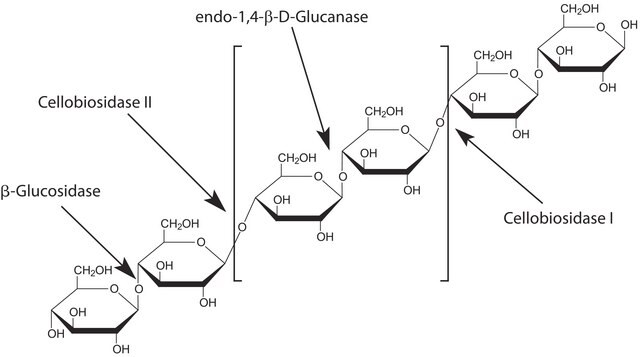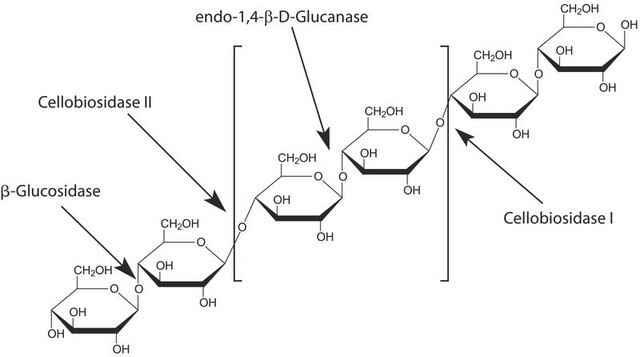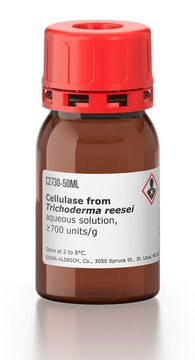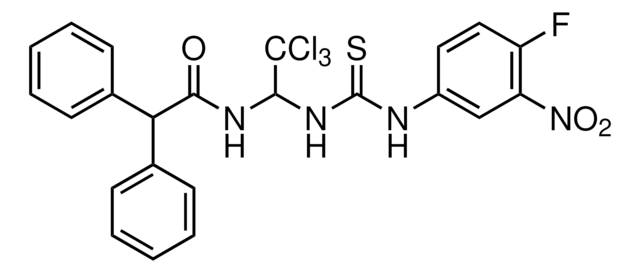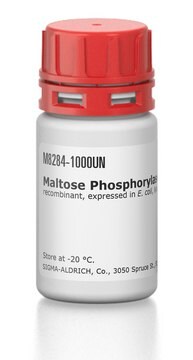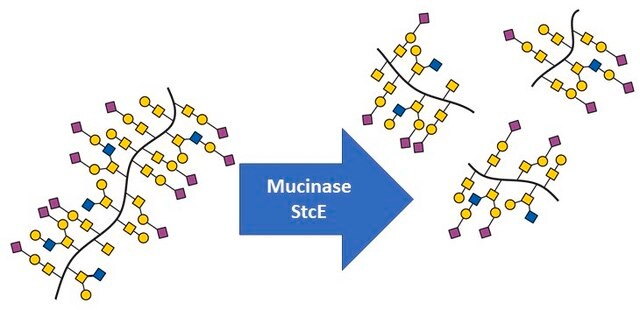추천 제품
재조합
expressed in corn
형태
liquid
특이 활성도
0.13 U/mg
환경친화적 대안 제품 특성
Design for Energy Efficiency
Learn more about the Principles of Green Chemistry.
sustainability
Greener Alternative Product
환경친화적 대안 카테고리
배송 상태
dry ice
저장 온도
−20°C
일반 설명
Cellubiohydrolase I is an enzyme present in many fungi, but particularly wood rot fungi. It is a monomer of 53 kDa with a catalytic domain and a cellulose binding domain. The reaction adds water to the glucose bonds in cellulose (non-reducing ends of the chain), yielding cellobiose.
We are committed to bringing you Greener Alternative Products, which adhere to one or more of The 12 Principles of Greener Chemistry. This product has been enhanced for energy efficiency. Find details here.
애플리케이션
Cellobiohydrolase I can be used in combination with endocellulases and b-glucosidase to produce glucose from cellulose.
생화학적/생리학적 작용
Cellobiohydrolase (CBH) is a cellulase which degrades cellulose by hydrolysing the 1,4-β-D-glycosidic bonds. CBH is an exocellulase which cleaves two to four units from the ends of cellulose. CBH I cleaves progressively from the reducing end. CBH I is commonly used in detergents for cleaning textiles. Its ezymatic activity ranges from 37° C to 50° C, with its optimal temperature being approximately 45° C. The optimum pH for the enzyme is 5-6.
단위 정의
Unit Definition: A unit will turn over 1 nmole of methyl-umbelliferyl beta-D cellobioside per min at pH 5 at 50° C.
물리적 형태
Provided as an ammonium sulfate precipitate with the source as recombinant maize.
신호어
Danger
유해 및 위험 성명서
예방조치 성명서
Hazard Classifications
Resp. Sens. 1
Storage Class Code
10 - Combustible liquids
WGK
WGK 3
Flash Point (°F)
Not applicable
Flash Point (°C)
Not applicable
시험 성적서(COA)
제품의 로트/배치 번호를 입력하여 시험 성적서(COA)을 검색하십시오. 로트 및 배치 번호는 제품 라벨에 있는 ‘로트’ 또는 ‘배치’라는 용어 뒤에서 찾을 수 있습니다.
Oren Yaniv et al.
Acta crystallographica. Section D, Biological crystallography, 68(Pt 7), 819-828 (2012-07-04)
The crystal structure of the family 3b carbohydrate-binding module (CBM3b) of the cellulosomal multimodular hydrolytic enzyme cellobiohydrolase 9A (Cbh9A) from Clostridium thermocellum has been determined. Cbh9A CBM3b crystallized in space group P4(1) with four molecules in the asymmetric unit and
Jenni Liisa Rahikainen et al.
Bioresource technology, 146, 118-125 (2013-08-08)
Non-productive enzyme adsorption onto lignin inhibits enzymatic hydrolysis of lignocellulosic biomass. Three cellobiohydrolases, Trichoderma reesei Cel7A (TrCel7A) and two engineered fusion enzymes, with distinctive modular structures and temperature stabilities were employed to study the effect of temperature on inhibition arising
Nicolaj Cruys-Bagger et al.
The Journal of biological chemistry, 287(22), 18451-18458 (2012-04-12)
The transient kinetic behavior of enzyme reactions prior to the establishment of steady state is a major source of mechanistic information, yet this approach has not been utilized for cellulases acting on their natural substrate, insoluble cellulose. Here, we elucidate
Nicolaj Cruys-Bagger et al.
Biotechnology and bioengineering, 109(12), 3199-3204 (2012-07-07)
An amperometric enzyme biosensor for continuous detection of cellobiose has been implemented as an enzyme assay for cellulases. We show that the initial kinetics for cellobiohydrolase I, Cel7A from Trichoderma reesei, acting on different types of cellulose substrates, semi-crystalline and
Zachary K Haviland et al.
The Journal of biological chemistry, 297(3), 101029-101029 (2021-08-03)
Understanding the mechanism by which cellulases from bacteria, fungi, and protozoans catalyze the digestion of lignocellulose is important for developing cost-effective strategies for bioethanol production. Cel7A from the fungus Trichoderma reesei is a model exoglucanase that degrades cellulose strands from
자사의 과학자팀은 생명 과학, 재료 과학, 화학 합성, 크로마토그래피, 분석 및 기타 많은 영역을 포함한 모든 과학 분야에 경험이 있습니다..
고객지원팀으로 연락바랍니다.